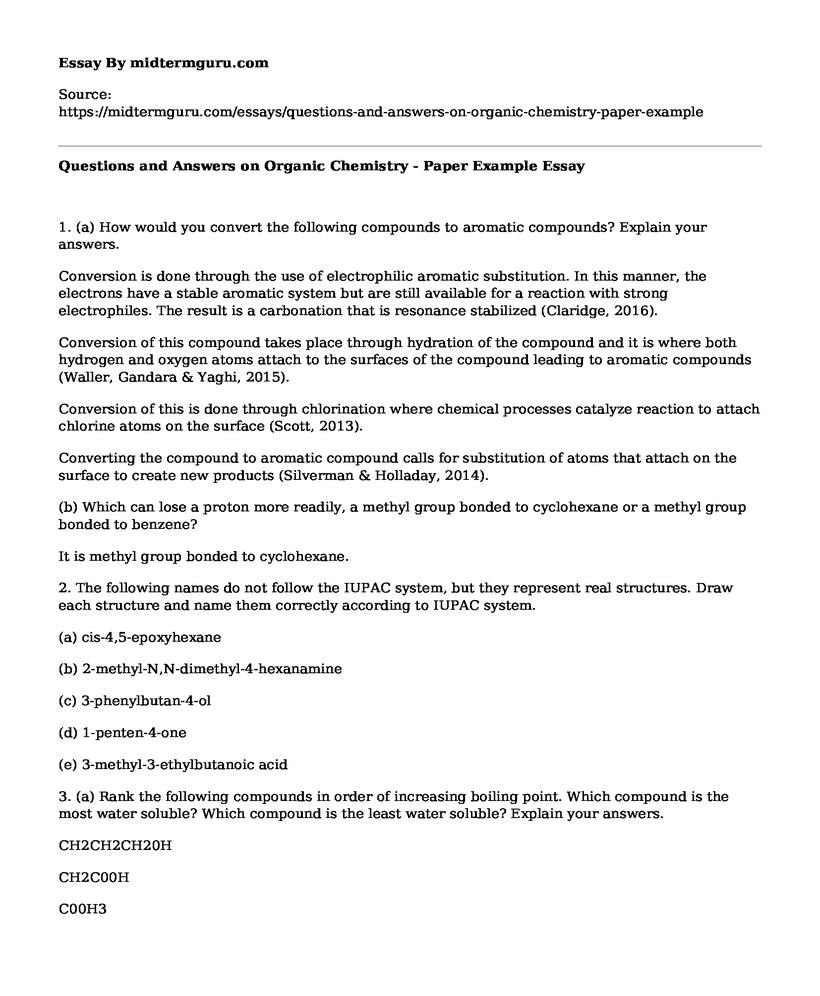1. (a) How would you convert the following compounds to aromatic compounds? Explain your answers.
Conversion is done through the use of electrophilic aromatic substitution. In this manner, the electrons have a stable aromatic system but are still available for a reaction with strong electrophiles. The result is a carbonation that is resonance stabilized (Claridge, 2016).
Conversion of this compound takes place through hydration of the compound and it is where both hydrogen and oxygen atoms attach to the surfaces of the compound leading to aromatic compounds (Waller, Gandara & Yaghi, 2015).
Conversion of this is done through chlorination where chemical processes catalyze reaction to attach chlorine atoms on the surface (Scott, 2013).
Converting the compound to aromatic compound calls for substitution of atoms that attach on the surface to create new products (Silverman & Holladay, 2014).
(b) Which can lose a proton more readily, a methyl group bonded to cyclohexane or a methyl group bonded to benzene?
It is methyl group bonded to cyclohexane.
2. The following names do not follow the IUPAC system, but they represent real structures. Draw each structure and name them correctly according to IUPAC system.
(a) cis-4,5-epoxyhexane
(b) 2-methyl-N,N-dimethyl-4-hexanamine
(c) 3-phenylbutan-4-ol
(d) 1-penten-4-one
(e) 3-methyl-3-ethylbutanoic acid
3. (a) Rank the following compounds in order of increasing boiling point. Which compound is the most water soluble? Which compound is the least water soluble? Explain your answers.
CH2CH2CH20H
CH2C00H
C00H3
Compound that is most soluble is CH2CH2CH20H and the least soluble is CH2C00H. This is because the higher the number of carbon-carbon atoms, the compounds become more stable.
(b) The boiling point of 2-butanone (80 0C) is significantly higher than the boiling point of diethyl ether (35 0C), even though both compounds exhibit dipoledipole interactions and have comparable molecular weights. Offer an explanation.
It is because 2-butanone is a ketone and a ketone has higher boiling point and it is more polar (Furukawa et al., 2013).
(c) Explain why HCOOH (formic acid) has a lower pKa than acetic acid (3.8 versus 4.8).
This is because the methyl group in the acid is electron donating in the conjugate base of acetic acid; this destabilizes the conjugate base by worsening the existing negative formal charge on the deprotonated oxygen. On the occasion when the same is in a formic acid, the electron donating methyl is absent in lieu of hydrogen, the same is either donating or withdrawing (Silverman & Holladay, 2014).
4. Show how you would synthesize the following compounds, starting with benzene and any necessary reagents.
(a) 3-phenylpropan-1-ol
The synthesis of the compound takes from the reduction of cinnamyl alcohol of cinnamaldehyde through various means of reduction (Claridge, 2016).
(b) m-bromonitrobenzene
Synthesis of m-bromonitrobenzene requires adding silver sulfate to nitrobenzene and bromine in a condition of concentrated sulfuric acid and water. The resulting mixture is shaken at room temperature for 16 hours then silver bromide is filtered then diluted with water thereby resulting to m-bromonitrobenzene (Scott, 2013).
(c) 1,2-dichloro-4-nitrobenzene
The compound is formed from the replacement of one H atom with nitrofunctional group, the compound is therefore an intermediate in the synthesis of agrochemicals (Waller, Gandara & Yaghi, 2015).
5. (a) Identify reagents af in the following scheme:
H+, H2O
PBr3
Mg (0), ether, then C02
LiAlH4
CO2
OH-
(b) Addition of HBr to 1-phenylpropene yields only (1-bromopropyl) benzene.
Propose a mechanism for the reaction, and explain why none of the other
regioisomer is produced.
The mechanism for the reaction is called alkene bromination. The reason why none of the oter regioisomer is produced is because the cyclic bromonium is formed first the followed by the nucleophilic attack by the residual bromide ion (Waller, Gandara & Yaghi, 2015).
References
Claridge, T. D. (2016). High-resolution NMR techniques in organic chemistry (Vol. 27). Elsevier.
Furukawa, H., Cordova, K. E., OKeeffe, M., & Yaghi, O. M. (2013). The chemistry and applications of metal-organic frameworks. Science, 341(6149), 1230444.
Scott, A. I. (2013). Interpretation of the Ultraviolet Spectra of Natural Products: International Series of Monographs on Organic Chemistry (Vol. 7). Elsevier.
Silverman, R. B., & Holladay, M. W. (2014). The organic chemistry of drug design and drug action. Academic press.
Waller, P. J., Gandara, F., & Yaghi, O. M. (2015). Chemistry of covalent organic frameworks. Acc. Chem. Res, 48(12), 3053-3063.
Cite this page
Questions and Answers on Organic Chemistry - Paper Example. (2021, Jun 17). Retrieved from https://midtermguru.com/essays/questions-and-answers-on-organic-chemistry-paper-example
If you are the original author of this essay and no longer wish to have it published on the midtermguru.com website, please click below to request its removal:
- African and Asian Origin - Essay Sample
- Politics Essay Sample: Political Geography and Theoretical Models
- Problems and Solutions on Engineering Mathematics - Paper Example
- Geography Paper Example: What Is Hong Kong?
- Chemistry Paper Example on Hydrogen Element
- Paper Example on Catalyst Used in Chlorobezene Production
- Discovering the Universe - Paper Example







